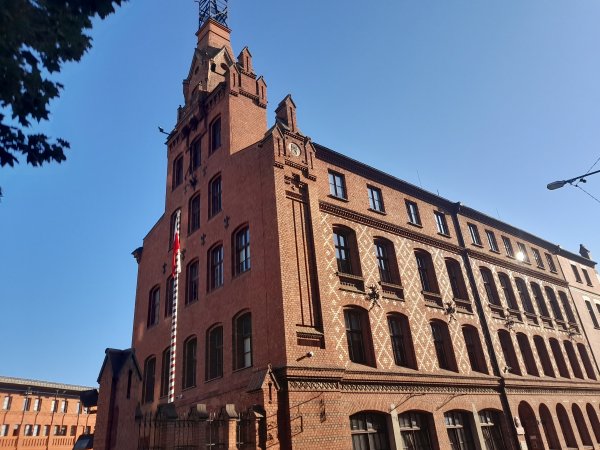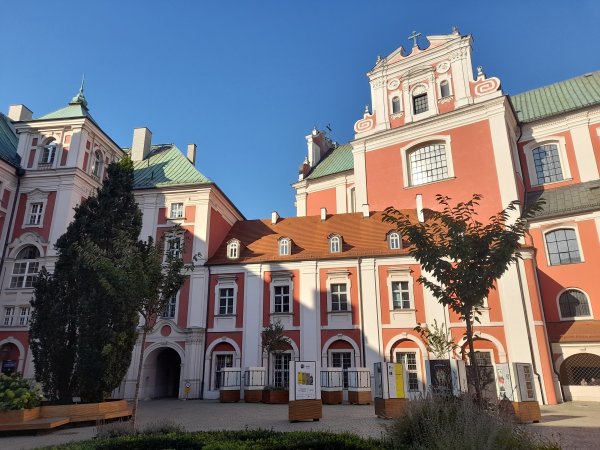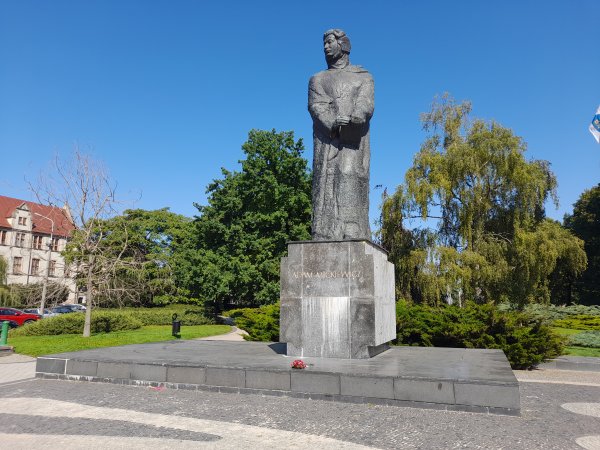
Spontaneity is a travelers’ skill that most probably I have already mentioned plenty of times. However, courage is only one factor when one looks for an spontaneous trip, and other aspects also matter, such as free time, being familiar with the destination, and of course, the budget. In my case, all of these circumstances met each other. Since I had been missing Poland and my stay there for a while, I chose to return to this beautiful nearby country which shares so much history with Hungary.
I think almost all my Polish trips and experiences are covered on this blog: I had articles about Katowice and Opole, Cracow and Wrocław, Warsaw, Upper-Silesia and Lower-Silesia and even about holiday traditions and cultural connections.
However, it is still, let’s say, just the beginning, because I was always thinking that I had never been yet to one of the three crucial historical regions of Poland.


I already knew Lesser-Poland (Małopolska with the capital Cracow/Kraków) and Mazovia (Mazowsze, with the capital Warsaw), but I had always wanted to go to Greater-Poland (Wielkopolska) as well, which represents a very deep national spirit indeed with dozens of stories and legends.
Accompanied by two further regions, Silesia (Śląsk) and Pomerania (Pomorze) these five areas include the vast majority of the historical Poland (of course, there are former Eastern territories like Lwów, Wilno or Stanisławów, but it would be a different tale for now).


Seeing Poland again was not just a trip of novelties, but also a trip of recreating some old and familiar vibes. On my way there, I was, as usual, crossing Ostrava where I lived for one year, and then I had to wait for my connection in Rybnik – a city I wrote about before.
Back then it was winter, there was a pandemic, so everything was dark, cold, empty and overcast. This time it was a pleasure to see the main square and the surrounding streets full of people, colors and sunshine and to get a different view on the same city after a couple of years.


My main destination was, however, the capital of Greater-Poland, Poznań: an amazing city lying along two rivers, Warta and Cybina, while plenty of lakes and islands shape the landscape of this wonderful area. Just like Warsaw and Cracow, Poznań also served as the capital of the Kingdom of Poland for a short period in the Middle Ages.
According to the legend, its name comes from the Polish verb poznać (to recognize), since this was the place where the three Slavic forefathers, Lech, Czech and Rus (ancestors of Poles, Czechs and Ruthenians) saw each other once again after a long time.
Actually, more southerly along river Warta, in the town of Rogalin, there are still three oaks named after the three forefathers. Maybe I will also be able to see them someday, as I visited another legendary oak tree in Poland, Bartek, while travelling in the Holy Cross (Świętokrzyskie) Voivodeship.


The architecture of the city has various motifs and elements that make it extraordinary and unique: for instance, one can notice the typical reddish colors of the ‘Silesian’ architecture, just like in Katowice or Wrocław – especially on official state buildings, stations and some churches, but there are also many ornaments that recall the Renaissance or the Classicist style and bring Poznań closer to Warsaw and Cracow in terms of appearance.


There is no wonder of the classicist style taking into account that after the tragical partition of the First Republic of Poland (which was technically an electoral kingdom), Poznań and Greater-Poland became the territories of Prussia.
The city that was called Posen in the Prussian-German times, therefore (at least according to me), it also shares many characteristics with East-German cities like Berlin or Dresden.



One of the most iconic German heritages, the Imperial Castle (Zamek Cesarski), located in the center and looking like a fairy tale castle, serves as a cultural center today with plenty of exhibitions, cinema rooms and theater halls.



However, Poznań is a city that can be proud not only of having an Imperial Castle, but also a Royal one: Zamek Królewski, the Royal Castle reminded me to the marvelous medieval towers of the Wawel Hill in Cracow or Brzeg and Legnica.
Thus, it took me only a second to fall in love with it. Of course, there is no castle without a museum of the local history here, so you can also visit the one inside. To be honest, I quite simply did not have the time to enter the museum, but I left the city with the hopes of returning someday to make up what I have missed.



While walking close to this castle, passing by a statue of St. George, we can arrive at the Franciscan Monastery (Klasztor Franciszkanów), which is one of the most fascinating and decorative churches of Poznań all together with the Basilica of Our Lady, which is also dedicated to St. Mary Magdalene and St. Stanisław.



Bishop St. Stanisław is also an interesting figure among Polish saints, because there is a legend that says he resurrected a noble man, Piotrowin just in order to summon him as a witness on a trial (there is even a painting inside the church of this scene).
Apart from the overdecorated, mesmerizing red, black and golden Catholic altars, I also noticed a very particular thing in the churches of the city. Namely, it was the symbol of the national coat-of-arms, the Polish eagle.



Although the white eagle was initially a pagan totem animal, has a significant role in the area and can be spotted in many churches of Wielkopolska. (We will get back to this later where it comes from.)
I also need to mention the Church of the Sacred Heart of Jesus and St. Florian, a treasure located in a district called Jeżyce. Maybe it would not be so fabulous for everyone as it was for me, but I would totally highlight it among the dozens of churches you can find in Poznań.



The best-known treasure and touristic heart of the center though is the Old Market Square (as in every Polish town: the Stary Rynek), and of course, its central and obligatory component is the Ratusz (Town’s Hall), which can also be a familiar name for those who have already traveled a bit in Poland.
Apart from Ratusz, the beautiful composition of the main square also consist of the Croissant Museum (Rogalowe Muzeum) and there are many town houses all around the square, just like in Wrocław for instance.



Unfortunately, luck was not on my side this time, and the entire square was under renovation. Nearly everyone had mentioned to me the Rynek on the first place in terms of sights in Poznań, but this way I could not see this very heart of Poznań in its whole shining beauty.
Neither could I have a close look on the Proserpina Fountain which tells a legend about a rich widow’s ghost, or the town’s other symbols, the Poznań Goats (Koziołki Poznańskie - literally ‘Little Goats’ which happens to be one of the cutest Polish expressions in my opinion).



Although the goat is the symbol of the coat-of-arms of another great Polish city, Lublin, the animal also has a remarkable presence in Poznań, and you can see them not only on the tower of the Town’s Hall, but there is also a sculpture of them in a small nearby square.
There are some small tales and explanations where the goat comes from, but apparently it is so deeply in Stary Rynek’s symbolism that it is just easier to accept it as an inalienable fact of the place. Goats and eagles are not the only legendary animals in the city: namely, there is a story about Przemek, a young trumpet player who once saved the King of Crows.
In return, he got a silver horn from the king who told him that he can call his army in danger. When enemies attacked Poznań later on, Przemek just had to blow the silver horn on the top of the Ratusz tower, and different birds: crows, ravens, jackdaws and magpies appeared from the four direction of the world to save the dwellers.


If you are interested in the modern history of Poland, you can also find the Museum of the 1918 Uprising in Greater-Poland here on the Market Square.
After being vanished from the map of Europe for more than a century, Poland was reestablished as a modern nation state after the First World War - but not so easily as we learnt it at school.
The will of the great powers was one thing, but it was also the will of the Polish people that united the country again through a series of bloody uprisings and local wars (against Germany, Czechoslovakia, the Soviet Union and Ukraine) that I already mentioned in terms of Silesia before.


There is a special sight that I must mention at this point, because it is strongly connected to my experiences from before. When I lived in different parts of Silesia, it was very typical in some key cities that former factory buildings were turned into shopping malls in a very smart and reasonable way; that was what I noticed discovering Nová Karolina in Ostrava and Silesia City Center in Katowice.


However, Poznań lifted this tendency to a brand-new level with Stary Browar, the former brewery of the city which nowadays serves as a shopping mall as well. It was incredible to see the huge halls, chimneys and glass windows where thousands of workers used to work day by day.
I felt that the old spirit of the factory remained among the walls, and although the function of the building has changed, it is as much full of life as during the times of the local beer production before. I think all of these buildings show a great example of renovating and recycling, but also of preserving the past.



Let’s move forward. Another remarkable square in the center is Plac Wolności (Liberty Square), which hosts the Raczyński Library, the National Museum, a Fountain with a contemporary art installation and a miraculous theater building, which’s facade has some special neon lights during the night stating wolność: freedom.
There is a theater building which is even more impressive though, and it is the one of the Grand Theatre (Teatr Wielki), guarded by two lions along the stairs, which made it a bit similar for me to Teatro Massimo’s entrance in Palermo and the National Museum of Szeged here in Hungary.



The theater is located by the Mickiewicz Park, one of the greenest and most peaceful areas of the city, with plenty of respectable trees and a charming fountain in the middle.
Mickiewicz, who is the namesake of the city’s university as well, is considered as one of the most important Polish poets: Juliusz Słowacki, Zygmunt Krasiński and Adam Mickiewicz together are often referred as the Three Bards.
They all lived and worked in the 19th century, in those tough times when Poland was entirely ereased from the map – thus they spent many years in emigration, far away from the motherland (actually the Polish word for homeland, ojczyzna literally means 'fatherland', just like in German for instance).


The square between the Imperial Castle and the park is also named after Mickiewicz, who has a full figure statue there. However, it is not the most important monument of the square, but it’s the memorial crosses for the protests of 1956 in Poznań against the Communist regime.
These protests also have an extremely important role in the modern history of Hungary, because the famous revolution of 1956 in Hungary against the Stalinist ruling power began as a solidarity protests following the one in Poznań.


Another theater a bit further is the New Theatre (Teatr Nowy), which is known also for its namesake, legendary Polish actor Tadeusz Łomnicki. He played the role one of the protagonists, Michał Wołodyjowski in Jerzy Hoffman’s historical movies, Colonel Wołodyjowski (1969) and The Deluge (Potop, 1974).
These works were based on the novels of the same title by Nobel prize winner Henryk Sienkiewicz, whose three novels (completed by With Fire and Sword) form all together the so-called Trilogy.


Łomnicki's name and face became associated with Wołodyjowski, 'the Little Knight': the best soldier and swordslinger of the Rzeczpospolita (a special phrase used almost exclusively for the Republic of Poland).
However, he was also a talented stage actor in theaters. The reason why he is related to Poznań is also the fact that he died during a main theatrical rehearsal while having the role of King Lear of Shakespeare.


When he was young, as many other Poles, he was also fighting against the Nazis in the Second World War as the member of the scout organization Szare Szeregi ('Gray Ranks').
As a matter of fact, I also found a nice memorial monument representing eagles and dedicated to this organization and other antifascist partisan movements, which I most probably would not have noticed if I had not read this fact about him before.
Well, that is all what I had to say about Poznań for now, putting mainly the architecture and the history in the focus. Next time we are going to see a different side of the city... and I promise that it will still not be the end!
